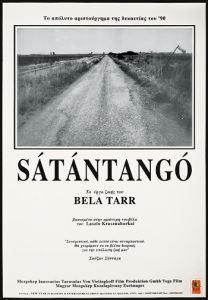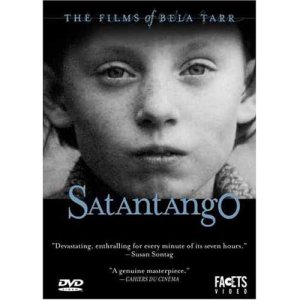Sátántangó is a four hundred and thirty-two minute movie; it is very, very long. It has three things in common with the Lord of the Rings: one, length; two, a great deal of walking (perhaps too much); and three, it is a masterwork of cinema. I am not sure if there are many ways that I can convince anyone to spend more than seven hours watching a movie that could have been easily cut down to four and a half hours.
Bela Tarr employed incredibly long takes throughout the film. Most of the shots last nearly ten minutes and it seems that those scenes are bookended with a minute or two on either side of people walking into and away from the scene, or watching other characters, or sometimes even nothing, before any mumblings of dialogue.
That will not sell the movie; I know that. Again, I don’t think this is something I can sell. The movie is not for everyone and I doubt I would have ever spent the time to watch it if it wasn’t for this project. I am, however, excited to watch it again in a couple of years; it really is quite marvelous. Sátántangó is a beautifully shot film. The benefit of the long takes is that it transports the viewers into the film as a silent partner, and it seems that you have a relationship with the characters by the end.
The film is broken into twelve chapters, with the most powerful and uneasy being the fifth chapter, “Felfeslők.” The entire story hinges on this fifty-one-minute story about Estike, a troubled child in the communal farm that the film surrounds. Of everything that I have seen to date with this project (Shoah aside, for obvious reasons) it is the most disturbing and tragic length of film that I have seen. Between the cat Estike finds and the decision that she makes, any viewer should squirm, cry, and never look at mental health the same again.
Again, Sátántangó is not for everyone, but if you like arthouse pictures and films dripping with drama and life, you should watch the film. If you are a student or lover of film technique and photography, you should see the film. Beware though, you will wonder when it will end, and you will consider stopping it during Estike’s scenes, but power through and you will understand what I am saying. It is difficult to sell a movie that at times seems like a chore, but there is something about this film, and someday I really hope that I can find out what I mean.
Trailer
Important Links

